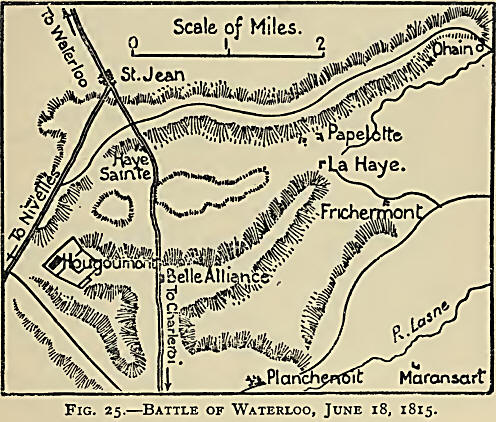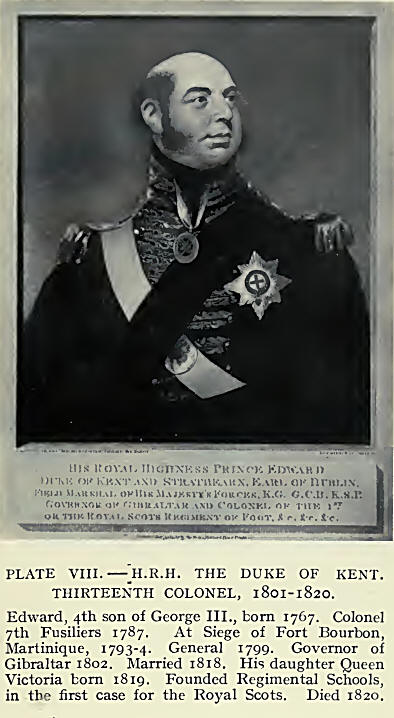|
Third Battalion at Quatre Bras—The attack on the Squares—
Waterloo—La Haye Sainte—The Royals and their Colours —The Fourth
Battalion—Bergen-op-Zoom.
On February 26 Napoleon left Elba, and reached France on
March 1. In three weeks he reinstated himself in power. Measures were
instantly concerted by the Allied Sovereigns to meet the danger. An army was
hastily assembled in the Netherlands, and placed under the command of
Field-Marshal the Duke of Wellington.
The third battalion embarked in May for Ostend with
Lieut.-Colonel Colin Campbell in command. On the night of June 15 it was at
Brussels, in Picton’s Fifth Division. When the alarm sounded, The Royals
fell in quickly and marched through the dark forest of Soignies. As they
were breakfasting there at eight o'clock, news came that the Allies were
hard pressed at Quatre Bras, and they left their meal unfinished and set out
again. No time was to be lost if the communications between the British and
the Prussians were to be saved. Twenty-one miles were covered by 3 p.m., a
great feat for hungry men marching in great heat through suffocating clouds
of dust. Arrived at Quatre Bras, the division lined up along the Namur-Nivelle
road. The light companies advanced against the French skirmishers and were
followed by the whole division (except the Ninety-second), suffering heavily
from musketry and heavy gunfire. Battalion squares were formed to resist the
fierce assaults of the French cavalry. The Forty-second and Forty-fourth
were surrounded in an especially exposed position: Picton led The
Royals1 and the Twenty-eighth in quarter column through the French troops
and ordered them to form a square.
The repeated and furious charges which ensued were invariably
repulsed by The Royals and the 28th, with the utmost steadiness and
consummate bravery, and although the Lancers individually dashed forward and
frequently wounded the men in the ranks, yet all endeavours to effect an
opening of which the succeeding squadron of attack might take advantage,
completely failed. The ground on which the square stood was such that the
surrounding remarkably tall rye concealed it in a great measure in the first
attacks, from the view of the French cavalry until the latter came quite
close upon it, but to remedy this inconvenience, and to preserve the impetus
of their charge, the Lancers had frequently to recourse to sending forward a
daring individual to plant a lance in the earth at a very short distance
from the bayonets, and then they charged upon the lance flag as a mark of
direction.
Despite shortness of ammunition The Royals never flinched.
Charged again and again by an infinite superiority of numbers, they never
gave way to the French cavalry. An eyewitness, who had been with the
regiment all through the Peninsula from Busaco to Bayonne, wrote that they
had never shown a more determined bravery—
Along the whole front of the central portion of the
Anglo-Allied army, the French cavalry was expending its force in repeated
but unavailing charges against the indomitable squares. The gallant, the
brilliant, the heroic manner in which the remnants of Kempt’s and Pack’s
Brigades held their ground, of which they surrendered not a single inch
throughout the terrific struggle of that day, must ever stand prominent in
the records of the triumphs and prowess of the British infantry.
When darkness fell the French retreated to the heights of
Frasnes, and The Royals were left on the field with 26 dead and 192 wrounded.
A renewal of the attack was expected in the morning, but the
French made none, and the division was moved back to high ground in front of
the village of Waterloo, and reached the new position as the sun went down.
The troops passed a miserable night, for rain fell in torrents, and a
thunderstorm burst over them. It was therefore a wet, weary, and half fed
regiment that woke to the morning of Waterloo.
The Fifth Division was in the British centre, and The Royals,
now again brigaded under Pack and much reduced in numbers, were commanded by
Major Robert Macdonald.
They stood on the north side of the Ohain road a little
north-east of La Haye Sainte, and facing south. After pounding them for two
hours with artillery, the Emperor sent 13,000 foot against Picton’s 3000.
The attack was repulsed by crashing volleys, and by a counter-charge w’hich
left many French prisoners in British hands. The cannonade began again, and
Pack's brigade had to withdraw to its original position behind a sheltering
ridge. Later in the afternoon the French captured the farm of La Haye Sainte
and the brigade was searched cruelly by the enemy's riflemen, but the
squares held their ground immovably and the French never crossed the Ohain
road. The crisis of the battle took place in another part of the field, and,
before the last effort of Napoleon's Old Guard, the firing from La Haye
Sainte had become feebler and feebler until it ceased. About eight o'clock
in the evening The Royals broke southwards across the road, and the long
disputed farm was taken. On this day they lost less heavily than at Quatre
Bras, 15 killed and 128 wounded, but on the two days their original strength
of 624 was reduced by 363. Four officers and the sergeant-major in turn fell
as they were carrying the King's colour. Amongst them was Ensign Kennedy. He
was carrying a colour in advance of the battalion and was shot in the arm:
he continued to advance, and was again shot, but this time killed or
mortally wounded. A sergeant then attempted to take the colour from him but
could not disengage his grip. He then threw the body over his shoulder and
rejoined the ranks of his battalion, through the chivalrous action of the
officer commanding the French battalion opposed to the Royals, who ordered
his men not to fire on the sergeant and his burden.

In such fashion did The Royal Scots make history at Waterloo.
The battalion marched into France with the army of
occupation, and after Napoleon’s flight “Waterloo” was added to the colours.
The return home was delayed until March 24, 1817, and the third battalion
was disbanded a month later, after fifteen years of glorious life. The men
who were not due for their discharge were transferred to the first and
second battalions.
The Fourth Battalion
We must now return to the other service battalion, the
fourth, raised at the same time. It was used mainly as a depot battalion for
providing the other three with drafts, and was recruited much from the
Militia. It is worth noting that about this time The Royals, alw'ays
pioneers in military reform, wfere the first to establish a regimental
school, at the instance of their colonel, The Duke of Kent. Its teachers
were often borrowed by other regiments, and its services to the general
cause of education were real and valuable.
It was not until 1813 that the fourth saw active service as a
separate unit.
The invasion of Russia by Napoleon, the burning of Moscow,
the disastrous retreat of the French army from the North, and the separation
of Prussia, Austria and other states from the interest of Napoleon, were
followed by a treaty of alliance and subsidy between Great Britain and
Sweden, in which it was stipulated that a Swedish army, commanded by the
Crown Prince, should join the Allies. On August 2 the battalion embarked,
under the command of Lieut.-Colonel Muller, for Stralsund, in Swedish
Pomerania, forming part of an expedition under the orders of Major-General
Gibbs. Thus The Royal Scots went to the same part of the world to which a
body of their daring countrymen, who formed the nucleus of this
distinguished regiment, proceeded exactly two hundred years before to engage
in the service of the Swedish monarch.

On Christmas Eve they were moved to Lubeck to support the
army of the Crown Prince of Sweden.
In the meantime, the Dutch were making an energetic struggle
to free themselves from the power of Napoleon, and a strong party had
declared in favour of the Prince of Orange. A British force was sent to the
Netherlands, under the orders of Sir Thomas Graham, and the fourth battalion
of The Royals was ordered to join the troops in Holland. It began its march
from Lubeck on January 17, 1814, and encountered many difficulties. While
crossing the forest of Shrieverdinghen, 120 men were lost in a snowstorm;
much suffering occurred during the journey, and on March 2 the men went into
cantonments at Rozendahl. The battalion was then ordered to join the force
destined to make an attempt on the strong fortress of Bergen-op-Zoom.
The attack was made on the night of March 8. The Royals
crossed the Zoom and forced an entrance by the water-port. Having gained
possession of the ramparts round the water-port gate, the battalion was
exposed to a heavy fire of grape and musketry from two howitzers and a
strong detachment of French marines. Two companies were detached to keep the
enemy in check, and were relieved every two hours by two other companies of
the battalion. They were thus engaged from eleven o'clock until daylight,
when the enemy made a furious attack in strong columns, which bore down all
before them. The two detached companies of The Royal Scots were attacked by
a host of combatants and driven in. A heavy fire of grape was opened upon
the battalion from the guns of the arsenal, and it was forced to retire by
the water-port gate, when a detached battery opened upon it. Being thus
placed between two fires, with a high palisade on one side and the Zoom
filled with the tide on the other, the battalion could do no more. The
colours were first sunk1 in the river Zoom by Lieutenant and Adjutant
Galbraith; the battalion then surrendered on condition that the officers and
men should not serve against the French until exchanged. The failure of the
coup-de-main on Bergen-op-Zoom occasioned an immense sacrifice of gallant
men. Forty-one were killed, 75 wounded, and 593 taken captive, but the
prisoners were allowed to return to England on April 8, and a month later
the battalion sailed for Canada, whence it returned in January 1816 and was
disbanded. |

